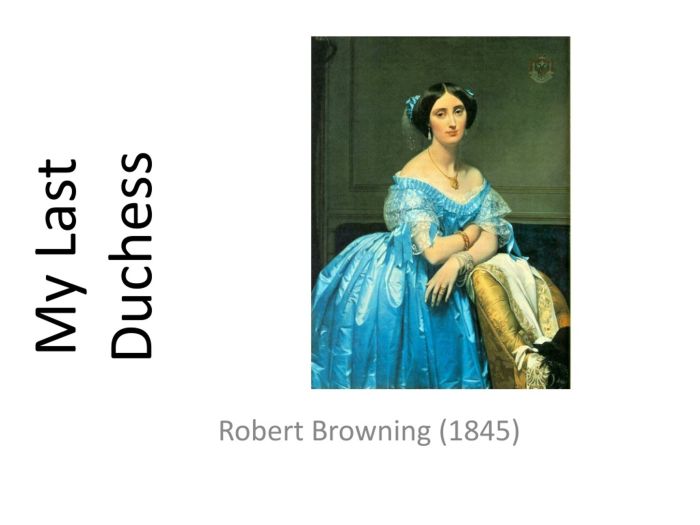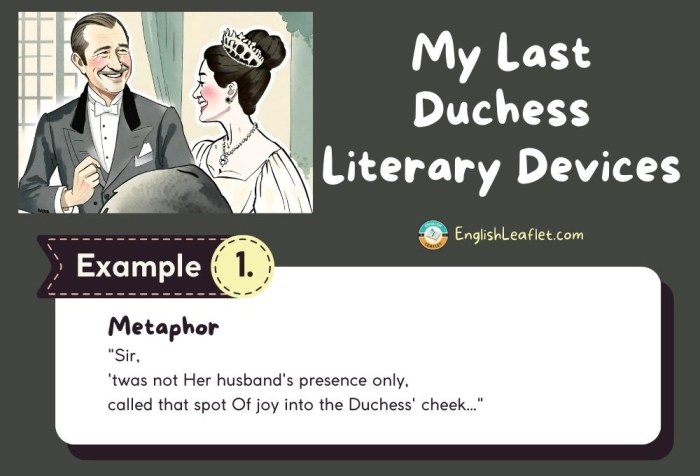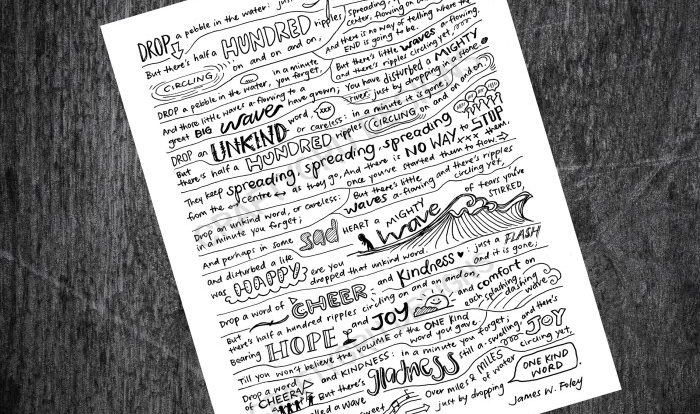My last duchess literary devices – The poem “My Last Duchess” by Robert Browning is a captivating exploration of power, jealousy, and repression, employing a range of literary devices that enhance its impact and meaning.
This essay will delve into the significance of the dramatic monologue, the use of figurative language, and the speaker’s tone, which collectively reveal the complex character of the Duke and the dynamics of his relationships.
1. Literary Devices in “My Last Duchess”: My Last Duchess Literary Devices

The Dramatic Monologue
The poem is written in the form of a dramatic monologue, in which the speaker, the Duke, addresses an unnamed listener. This allows the reader to gain insight into the Duke’s thoughts and feelings, as well as his character. The monologue is structured as a conversation, with the Duke frequently addressing the listener directly.
Figurative Language
The poem is rich in figurative language, including metaphors and similes. For example, the Duke refers to his wife as a “frail” and “fine” creature, comparing her to a delicate object. He also uses a simile to describe her smile, saying that it “turned to stone” when she saw a group of peasants dancing.
Tone and Characterization
The Duke’s tone throughout the poem is cold and detached. He speaks of his wife in a dismissive and condescending manner, revealing his arrogance and lack of empathy. His tone also suggests that he is trying to justify his actions, hinting at a darker and more sinister side to his character.
2. Symbolism and Imagery

Objects and Settings
The poem contains several objects and settings that are symbolic. For example, the “last duchess’s” portrait is a symbol of her memory and the Duke’s control over her. The “nine-hundred-year-old” oak tree is a symbol of the Duke’s ancient lineage and his desire for power.
Atmosphere and Mood, My last duchess literary devices
The poem’s imagery contributes to its atmosphere and mood. The use of dark and gloomy imagery, such as the “shadowed” corridor and the “pale” Duchess, creates a sense of mystery and unease. The Duke’s cold and detached tone adds to the poem’s chilling atmosphere.
Sensory Details
The poet uses sensory details to evoke a vivid picture in the reader’s mind. For example, the Duke describes the “sweet” smell of the flowers in the garden and the “warm” feel of his wife’s hand. These details help to create a rich and immersive experience for the reader.
3. Theme and Interpretation
Power, Jealousy, and Repression
The poem explores several themes, including power, jealousy, and repression. The Duke’s control over his wife is a symbol of his desire for absolute power. His jealousy of her perceived infidelity leads him to murder her, revealing his inability to accept any challenge to his authority.
Interpretation
The poem can be interpreted as a critique of the abuse of power and the destructive effects of jealousy. The Duke’s actions show the dangers of unchecked power and the lengths to which some people will go to maintain their control over others.
4. Poetic Structure and Form
Rhyme Scheme and Meter
The poem follows an ABAB rhyme scheme and is written in iambic pentameter. The regular rhythm and rhyme create a sense of flow and movement, enhancing the poem’s musicality.
Stanza Structure
The poem is divided into eight stanzas, each consisting of four lines. The stanzas are separated by a single blank line, creating a visual break in the text.
5. Historical and Cultural Context

Victorian Era
The poem was written in the Victorian era, a time of great social and economic change. The poem reflects the Victorian preoccupation with power, control, and social hierarchy.
Influence on Browning’s Work
The poem was influenced by Browning’s own experiences with marriage and loss. The death of his wife, Elizabeth Barrett Browning, in 1861, left a profound impact on him and may have influenced the themes of power and control in the poem.
Helpful Answers
What is the significance of the dramatic monologue in “My Last Duchess”?
The dramatic monologue allows the speaker to reveal his inner thoughts and feelings directly to the reader, providing a unique and intimate perspective on the events of the poem.
How does the use of figurative language contribute to the poem’s meaning?
Figurative language, such as metaphors and similes, creates vivid imagery and enhances the emotional impact of the poem, allowing the reader to experience the speaker’s emotions and motivations more deeply.
What does the speaker’s tone reveal about his character?
The speaker’s tone is often cold, detached, and controlling, suggesting a complex and potentially dangerous personality. His use of irony and understatement further reveals his manipulative nature.
